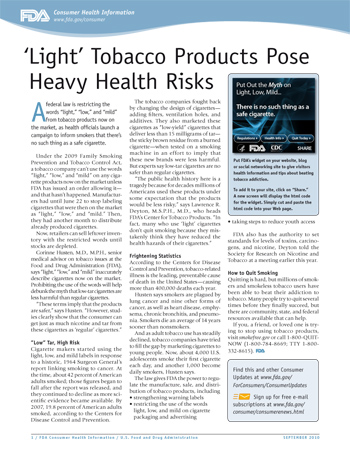For Consumers
“Light” Tobacco Products Pose Heavy Health Risks
 Get Consumer Updates by E-mail
Get Consumer Updates by E-mail
A federal law is restricting the words “light,” “low,” and “mild” from tobacco products now on the market, as health officials launch a campaign to inform smokers that there’s no such thing as a safe cigarette.
Under the 2009 Family Smoking Prevention and Tobacco Control Act, a tobacco company can’t use the words “light,” “low,” and “mild” on any cigarette products now on the market unless FDA has issued an order allowing it—and that hasn’t happened. Manufacturers had until June 22 to stop labeling cigarettes that were then on the market as “light,” “low,” and “mild.” Then, they had another month to distribute already produced cigarettes.
Now, retailers can sell leftover inventory with the restricted words until stocks are depleted.
Corinne Husten, M.D., M.P.H., senior medical advisor on tobacco issues at the Food and Drug Administration (FDA), says “light,” “low,” and “mild” inaccurately describe cigarettes now on the market. Prohibiting the use of the words will help debunk the myth that low-tar cigarettes are less harmful than regular cigarettes.
“These terms imply that the products are safer,” says Husten. “However, studies clearly show that the consumer can get just as much nicotine and tar from these cigarettes as ‘regular’ cigarettes.”
”Low” Tar, High Risk
Cigarette makers started using the light, low, and mild labels in response to a historic, 1964 Surgeon General’s report linking smoking to cancer. At the time, about 42 percent of American adults smoked; those figures began to fall after the report was released, and they continued to decline as more scientific evidence became available. By 2007, 19.8 percent of American adults smoked, according to the Centers for Disease Control and Prevention.
The tobacco companies fought back by changing the design of cigarettes—adding filters, ventilation holes, and additives. They also marketed these cigarettes as “low-yield” cigarettes that deliver less than 15 milligrams of tar—the sticky brown residue from a burned cigarette—when tested on a smoking machine in an effort to imply that these new brands were less harmful. But experts say low-tar cigarettes are no safer than regular cigarettes.
"The public health history here is a tragedy because for decades millions of Americans used these products under some expectation that the products would be less risky,” says Lawrence R. Deyton, M.S.P.H., M.D., who heads FDA’s Center for Tobacco Products. “In fact, many who use ‘light’ cigarettes don't quit smoking because they mistakenly think they have reduced the health hazards of their cigarettes."
Frightening Statistics
According to the Centers for Disease Control and Prevention, tobacco-related illness is the leading, preventable cause of death in the United States—causing more than 400,000 deaths each year.
Husten says smokers are plagued by lung cancer and nine other forms of cancer, as well as heart disease, emphysema, chronic bronchitis, and pneumonia. Smokers die an average of 14 years sooner than nonsmokers.
And as adult tobacco use has steadily declined, tobacco companies have tried to fill the gap by marketing cigarettes to young people. Now, about 4,000 U.S. adolescents smoke their first cigarette each day, and another 1,000 become daily smokers, Husten says.
The law gives FDA the power to regulate the manufacture, sale, and distribution of tobacco products, including
- strengthening warning labels
- restricting the use of the words light, low, and mild on cigarette packaging and advertising
- taking steps to reduce youth access
FDA also has the authority to set standards for levels of toxins, carcinogens, and nicotine, Deyton told the Society for Research on Nicotine and Tobacco at a meeting earlier this year.
How to Quit Smoking
Quitting is hard, but millions of smokers and smokeless tobacco users have been able to beat their addiction to tobacco. Many people try to quit several times before they finally succeed, but there are community, state, and federal resources available that can help.
If you, a friend, or loved one is trying to stop using tobacco products, visit http://smokefree.gov or call 1-800-QUIT-NOW (1-800-784-8669; TTY 1-800-332-8615).
This article appears on FDA's Consumer Updates page, which features the latest on all FDA-regulated products.
Posted: September 28, 2010
Related Consumer Updates
Regulating Tobacco: Q&A with Lawrence Deyton, M.S.P.H., M.D. FDA 101: Smoking Cessation Products Less Risky Tobacco Product? Only if the Science Says So What Are You Smoking (or Chewing or Inhaling)? Why Do People Use Tobacco? Looking for Answers Why is the Great American Smokeout Important? FDA Modernizing Regulatory Science FDA Unveils New Cigarette Health Warnings E-Cigarettes: Questions and Answers FDA Warns of Health Risks Posed by E-Cigarettes
For More Information
- Family Smoking Prevention and Tobacco Control Act
Dr. Lawrence Deyton - Remarks to the Society for Research on Nicotine and Tobacco 2010 Annual Meeting Smoking Cessation Products to Help You Quit Light, Low, Mild or Similar Descriptors FDA Parental Advisory on Flavored Tobacco Products - What You Need To Know 1-800-QUIT NOW 









